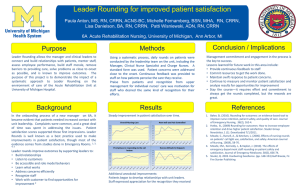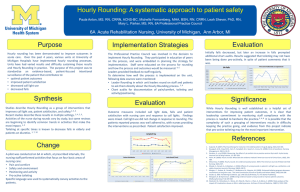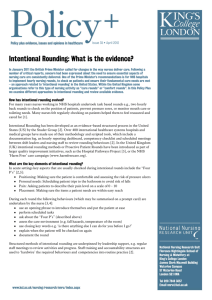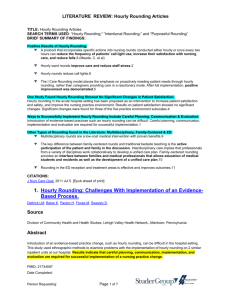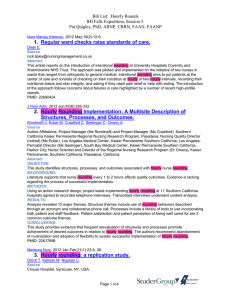REPORT: October/November 2006 - Minnesota Hospital Association
advertisement
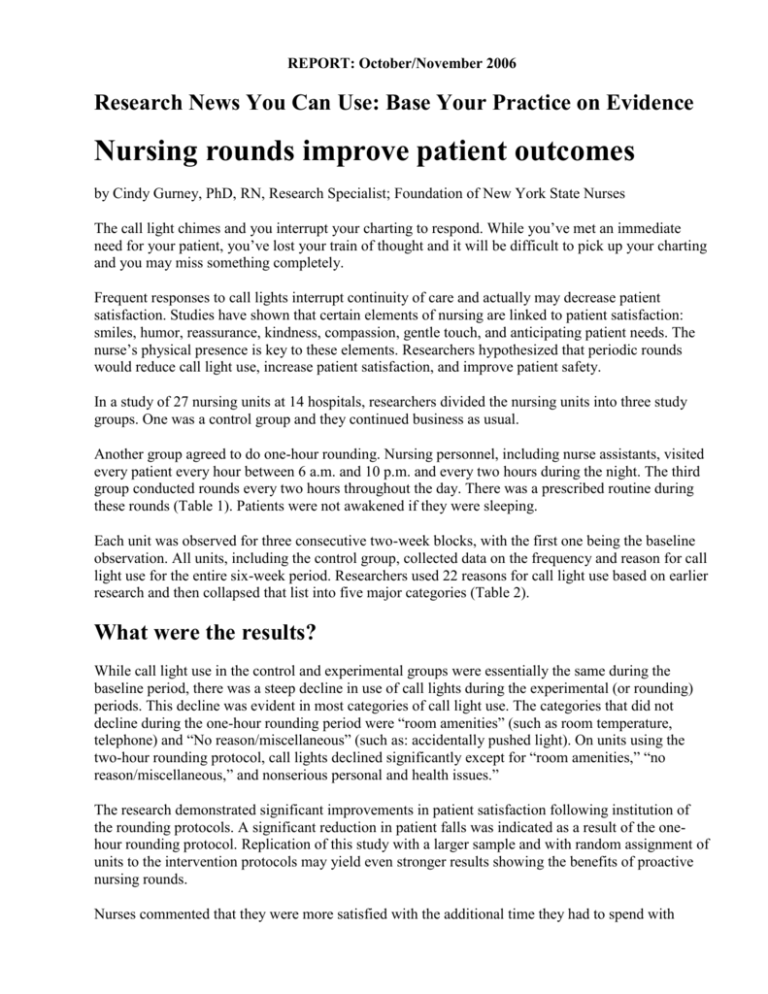
REPORT: October/November 2006 Research News You Can Use: Base Your Practice on Evidence Nursing rounds improve patient outcomes by Cindy Gurney, PhD, RN, Research Specialist; Foundation of New York State Nurses The call light chimes and you interrupt your charting to respond. While you’ve met an immediate need for your patient, you’ve lost your train of thought and it will be difficult to pick up your charting and you may miss something completely. Frequent responses to call lights interrupt continuity of care and actually may decrease patient satisfaction. Studies have shown that certain elements of nursing are linked to patient satisfaction: smiles, humor, reassurance, kindness, compassion, gentle touch, and anticipating patient needs. The nurse’s physical presence is key to these elements. Researchers hypothesized that periodic rounds would reduce call light use, increase patient satisfaction, and improve patient safety. In a study of 27 nursing units at 14 hospitals, researchers divided the nursing units into three study groups. One was a control group and they continued business as usual. Another group agreed to do one-hour rounding. Nursing personnel, including nurse assistants, visited every patient every hour between 6 a.m. and 10 p.m. and every two hours during the night. The third group conducted rounds every two hours throughout the day. There was a prescribed routine during these rounds (Table 1). Patients were not awakened if they were sleeping. Each unit was observed for three consecutive two-week blocks, with the first one being the baseline observation. All units, including the control group, collected data on the frequency and reason for call light use for the entire six-week period. Researchers used 22 reasons for call light use based on earlier research and then collapsed that list into five major categories (Table 2). What were the results? While call light use in the control and experimental groups were essentially the same during the baseline period, there was a steep decline in use of call lights during the experimental (or rounding) periods. This decline was evident in most categories of call light use. The categories that did not decline during the one-hour rounding period were “room amenities” (such as room temperature, telephone) and “No reason/miscellaneous” (such as: accidentally pushed light). On units using the two-hour rounding protocol, call lights declined significantly except for “room amenities,” “no reason/miscellaneous,” and nonserious personal and health issues.” The research demonstrated significant improvements in patient satisfaction following institution of the rounding protocols. A significant reduction in patient falls was indicated as a result of the onehour rounding protocol. Replication of this study with a larger sample and with random assignment of units to the intervention protocols may yield even stronger results showing the benefits of proactive nursing rounds. Nurses commented that they were more satisfied with the additional time they had to spend with patients and the uninterrupted time they had for charting and patient education. They also noted that units were quieter with less frequent call-light chimes and chimes answered more quickly. Patients and nurses reported positive outcomes when nurses established systems for regular rounds. Prescribed protocols ensured that patient needs were handled proactively. As a result, nurses had more control over the course of their day, patients were more satisfied with their care, and, at least in the case of one-hour rounds, falls were prevented. This research deserves a look. You might find a similar program at your own facility could reap benefits for you and your patients. Meade, C.M., Bursell, A.L., Ketelsen, L. (2006). Effects of nursing rounds on patients’ call light use, satisfaction, and safety. American Journal of Nursing, 106(9) 58-70. Table 1: Nursing rounds protocol The following items will be checked and performed for each patient. Upon entering the room, tell the patient you are there to do your rounds. 1. Assess patient pain levels using a pain-assessment scale (if staff members other than RNs are doing the rounding and the patient is in pain, contact an RN immediately so the patient does not have to use the call light for pain medication). 2. Put medication as needed on RN’s scheduled list of things to do for patients and offer the dose when due. 3. Offer toileting assistance. 4. Assess the patient’s position and position comfort: ask if patient needs to be repositioned and is comfortable. 5. Make sure the call light is within the patient’s reach. 6. Put the telephone within the patient’s reach. 7. Put the TV remote-control and bed light switch within the patient’s reach. 8. Put the bedside table next to the bed. 9. Put the tissue box and water within the patient’s reach. 10. Put the garbage can next to the bed. 11. Prior to leaving the room, ask, “Is there anything I can do for you before I leave? I have time while I am here in the room.” 12. Tell the patient that a member of the nursing staff (use names on white board) will be back in the room in an hour (or two hours if two-hour protocol is used) to round again. (Meade, et al., p. 60) Table 2: Major categories of call light use Serious Medical Concern Secondary Medical Concerns Non-serious Personal or Health Issues Room Amenities No Reason/Miscellaneous "Reprinted from Report, The Official Newsletter of the New York State Nurses Association, Vol. 37, No. 9. with permission of the publisher, the New York State Nurses Association, Latham, NY."
